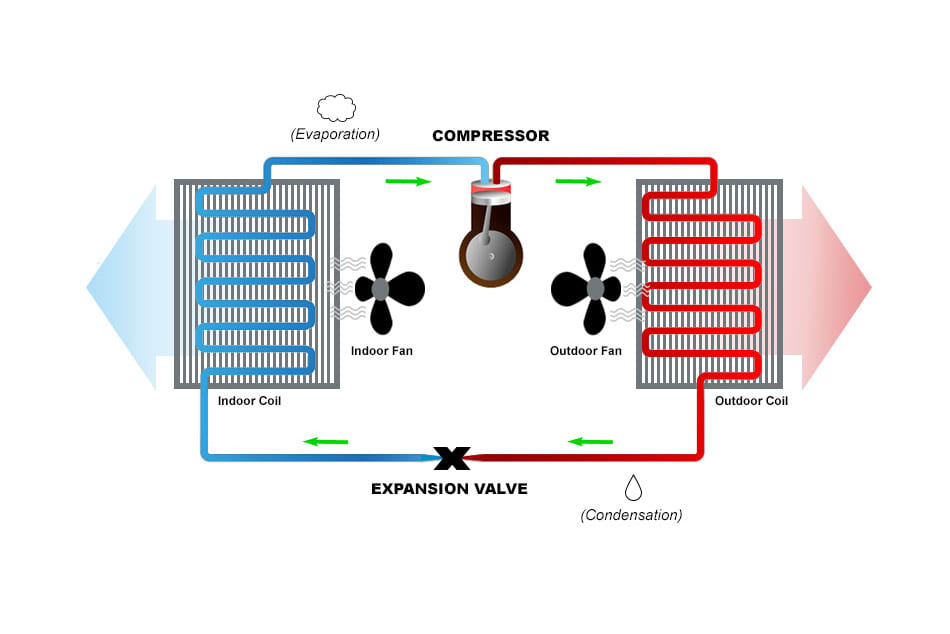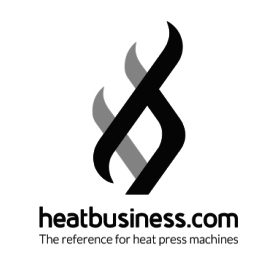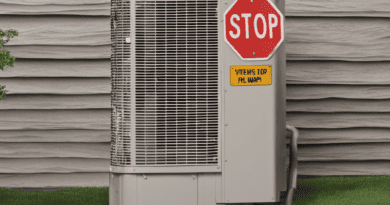What is a Heat Pump? Everything you need to know
Contents
- 1 What exactly is a heat pump?
- 2 How does a heat pump work?
- 3 What are the different types of heat pumps?
- 4 What are the benefits of using a heat pump?
- 5 What are the limitations of heat pumps?
- 6 What factors should I consider when choosing a heat pump?
- 7 What maintenance does a heat pump require?
- 8 What are the costs of installing a heat pump?
- 9 What tax credits and incentives are available for heat pumps?
What exactly is a heat pump?
A heat pump is a device that transfers heat energy from a source of heat to a destination called a heat sink. It moves thermal energy in the opposite direction of spontaneous heat transfer, by absorbing heat from a cold space and releasing it to a warmer one.
A refrigeration system is used to do this, usually involving a refrigerant that undergoes phase changes from a liquid to a gas and back again as it circulates through the system’s main components: the evaporator, compressor, condenser, and expansion valve. This allows a heat pump to move heat energy in either direction to cool or heat spaces.
Heat pumps are used for space heating, cooling, water heating, refrigeration, and other applications. They can extract heat from various sources like air, ground or water. Heat pumps move thermal energy in the same way a refrigerator moves heat from its inside to its external environment. But unlike a refrigerator, heat pumps can reverse the direction of heat transfer by using a valve which alters the pressure and flow of refrigerant. This makes heat pumps highly energy efficient systems for heating and cooling.

How does a heat pump work?
A heat pump works on the basic principle of refrigeration. It uses a refrigerant that absorbs heat and undergoes phase change from liquid to vapor when compressed. The main components of a heat pump system are:
- Evaporator – Absorbs heat from the air, water or ground into the refrigerant, causing it to evaporate.
- Compressor – Compresses the refrigerant vapor, raising its pressure and temperature.
- Condenser – Releases heat from the hot refrigerant to the air or water being heated. The refrigerant condenses back to a liquid.
- Expansion valve – Causes a pressure drop, allowing the refrigerant to evaporate again and repeat the cycle.
In heating mode, the refrigerant absorbs heat from a cold source via the evaporator. It is compressed to a hotter state by the compressor and then pumped into the condenser. Here it releases its heat to the warm space being heated. The cooled liquid refrigerant is returned to the evaporator via the expansion valve to continue the cycle.
In cooling mode, the cycle is reversed – heat is absorbed from the warm air or water being cooled into the refrigerant via the condenser. The evaporator then absorbs this heat from the refrigerant, cooling the air or water.
What are the different types of heat pumps?
There are several types of heat pumps classified by their heat source and sink:
- Air-to-air – Transfers heat between indoor and outdoor air. Used for space heating and cooling.
- Air-to-water – Transfers heat between air and water. Used for space and water heating.
- Water-to-water – Transfers heat to and from bodies of water like lakes, rivers. Used for space heating.
- Ground-to-air – Absorbs heat from the ground and transfers it indoors via refrigerant and a water loop buried underground.
- Ground-to-water – Transfers heat between the ground and water. Used for space heating and cooling.
Heat pumps can also be distinguished based on the refrigerant used – R410A and R32 are common refrigerants used in newer heat pump systems. The direction of heat transfer also classifies them into heating-only or reversible heating/cooling heat pumps.
What are the benefits of using a heat pump?
Some key benefits of using a heat pump are:
- Highly energy efficient – Heat pumps typically consume 1 unit of electricity to move 3-5 units of heat. This results in lower utility bills compared to electric resistance heating.
- Environmentally friendly – Heat pumps reduce carbon emissions by leveraging renewable heat sources like air and ground instead of burning fuels.
- Versatile – Heat pumps can provide heating, air conditioning, and hot water from a single system. Reversing valves allow bidirectional heating or cooling.
- Comfort – Heat pumps provide consistent indoor temperatures and can help regulate humidity levels.
- Cost effective – Though the upfront cost is higher, the operating costs are much lower than conventional HVAC systems.
- Long lifespan – Properly installed and maintained heat pumps can last over 15-20 years.
- Low maintenance – Heat pumps have few moving parts and require minimal maintenance.
What are the limitations of heat pumps?
Some drawbacks of using heat pumps:
- Performance declines in extreme cold – Most air-source heat pumps become less efficient below 30-40°F outdoor temperature. Additional backup heating may be needed in very cold climates.
- Higher upfront costs – Purchasing and installing a heat pump system costs more initially compared to gas furnaces or baseboard electric heating.
- Accessibility constraints – Ground-source heat pumps require sufficient outdoor space for buried piping. Air-source heat pumps need adequate external air flow.
- Acclimatization period – It can take some time to adjust to lower heating temperatures from heat pumps compared to other heating systems.
- Installation expertise needed – Proper sizing and installation of heat pumps requires specialized HVAC expertise. DIY installation is not recommended.
- Potential refrigerant leaks – Poor maintenance can lead to refrigerant leakage, reducing efficiency and harmful for the environment if not addressed promptly.
- Air flow disruptions – Placing objects on or around the outdoor unit can obstruct air flow and lower efficiency.
What factors should I consider when choosing a heat pump?
Some key factors to consider when selecting a heat pump:
- Intended application – Heating, cooling, hot water, or a combination
- Available space for indoor and outdoor units
- Climate and extreme temperatures in your location
- Heating and cooling loads for the space being conditioned
- Energy costs and incentives in your area
- Desired comfort levels and temperature control
- Noise levels from the outdoor unit
- Upfront purchase and installation costs
- COP (Coefficient of Performance) and EER (Energy Efficiency Ratio) ratings
- Type of refrigerant used
- Availability of rebates and financing options
- Manufacturer’s reputation and warranties
- Getting multiple quotes for brand, model, and installation
Properly sizing the heat pump capacity for your home’s needs and hiring a qualified installer is highly recommended for optimal performance. Seeking advice from energy auditors can also help determine the right system.
What maintenance does a heat pump require?
Some best practices for heat pump maintenance:
- Clean or replace air filters monthly – Dirty filters reduce air flow and efficiency.
- Clear debris around outdoor unit – Remove leaves, grass clippings that obstruct air flow.
- Inspect refrigerant lines – Check for damage and leaks. Address refrigerant issues promptly.
- Clean heat exchanger coils – Use a soft brush and mild detergent to remove dust and debris from coils.
- Check electrical components – Inspect wires, connections, capacitors, contactors etc. Replace worn parts.
- Inspect base pan drain – Ensure drain line is clear to avoid water overflow and moisture damage.
- Log runtime hours – Keep a record of runtime hours and replace parts that exceed lifespan.
- Annual professional servicing – Hire an HVAC technician to do a comprehensive inspection and tune-up.
- Test and replace components – Test components like sensors, valves, belts and motors. Replace any worn parts.
- Check refrigerant charge – Technician should check refrigerant levels and top up if low.
- Verify thermostat settings – Ensure temperature and mode settings match usage patterns for efficiency.
Regular maintenance ensures a heat pump system runs optimally, avoids premature breakdowns, and provides maximum savings over its lifespan.
What are the costs of installing a heat pump?
Heat pump installation costs typically range from $3,500 to $12,000 depending on the type, size and features. Here’s a breakdown of typical installation cost ranges:
- Air-source heat pumps – $3,500 to $7,000 installed
- Ductless mini-split heat pumps – $3,000 to $9,000 installed
- Geothermal heat pumps – $5,000 to $12,000 installed
- Ductwork modifications – $1,500 to $3,000 if needed
- Smart thermostats – $250 to $500
- Annual maintenance – $200 to $300
Key factors impacting overall installation costs:
- Type and size of heat pump system
- Ductwork – new install or modifications
- Location and accessibility of indoor and outdoor units
- Difficulty of installation and labor rates
- Additional components like thermostats and controls
- Permits and contractor fees if required
Getting multiple installation quotes and factoring available rebates and tax credits can help make heat pumps more affordable.
What tax credits and incentives are available for heat pumps?
Some financial incentives available for heat pumps:
- Federal Investment Tax Credit – Up to 30% of system cost until 2032
- State/utility rebates – Up to $800 per ton of capacity installed
- Property tax exemptions – For geothermal heat pump installation
- Sales tax exemptions – On purchase price in some states
- Low interest loans and financing – Through utilities and state programs
- Electric bill discounts – Lower rates offered by some utilities
- Renewable energy credits – For sale of power generated by geothermal systems
- Energy efficient mortgages – Include cost of heat pumps in mortgage
- Manufacturer/contractor discounts – On equipment, installation etc.
Checking Database of State Incentives for Renewables & Efficiency can identify specific incentives available by location. Taking advantage of these can offset the upfront cost of heat pump systems.
references:
https://www.carrier.com/residential/en/us/products/heat-pumps/what-is-a-heat-pump-how-does-it-work/


